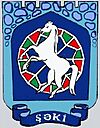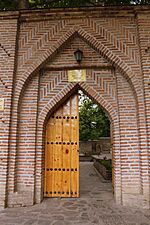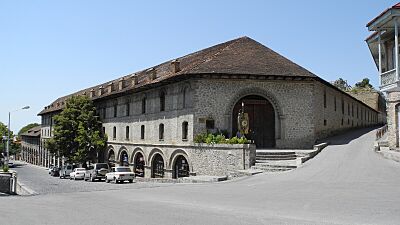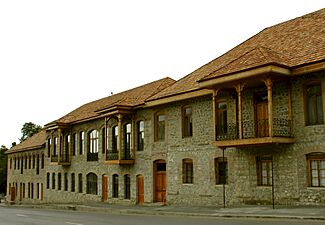Shaki, Azerbaijan facts for kids
Quick facts for kids
Shaki
Şəki
|
||
|---|---|---|
|
City
|
||
 |
||
|
||
 |
||
| Country | ||
| Region | Shaki-Zagatala | |
| Elevation | 700 m (2,300 ft) | |
| Population
(2020)
|
||
| • Total | 68,400 | |
| Time zone | UTC+4 (AZT) | |
| Postcode |
5500
|
|
| UNESCO World Heritage Site | |
|---|---|
 |
|
| Criteria | Cultural: ii, v |
| Inscription | 2019 (43rd Session) |
| Area | 120.5 ha |
| Buffer zone | 146 ha |
Shaki (Azerbaijani: Şəki) is a city in northwestern Azerbaijan. It is surrounded by the Shaki district. The city is located in the southern part of the Greater Caucasus mountains. It is about 240 kilometers (150 miles) from Baku, the capital of Azerbaijan. As of 2020, Shaki has a population of 68,400 people.
The city center and the famous Palace of Shaki Khans were added to the UNESCO World Heritage List in 2019. This happened because of their special architecture and long history. Shaki was once a very important trading hub along the ancient Silk Road.
Contents
What's in a Name?
Azerbaijani historians believe the name "Shaki" comes from an old tribe called the Sakas. These people arrived in the area of modern-day Azerbaijan around the 7th century B.C. They lived there for several centuries.
In old writings, the city's name appeared in different ways. Some examples are Sheke, Sheki, Shaka, and Shakki. Before 1968, the city was known as Nukha (Azerbaijani: Nuxa).
A Look Back: Shaki's History
Ancient Times in Shaki
People have lived in Shaki for a very long time, over 2700 years. The Sakas, an Iranian group, traveled from the Black Sea area. They came through the Derbend passage to the South Caucasus around 7th century B.C. They settled in a fertile area called Sakasena, and Shaki was one of their main settlements. The first settlement here dates back to the late Bronze Age.
Shaki was founded in the 8th century B.C. It became one of the largest cities in the Caucasian Albanian states in the 1st century. The main temple of the ancient Albanians was located in Shaki. Early on, the Albanians adopted Christianity.
Archaeological digs in 1902 found old pottery and a stone tombstone. These items, found in the village of Boyuk-Dakhna, date back to the 2nd century AD. They even had writings in Greek.
Shaki was an important city for politics and trade before the Arab invasion in 654. Later, when the Arab caliphate weakened, Shaki became part of an independent area. It was sometimes ruled by Armenian princes.
Shaki in the Feudal Era
In the 13th and 14th centuries, Shaki was part of the Shirvanshah state. Later, a local tribe called the Oirat took control. After the Hulagu Khan's rule ended, Shaki became independent under Sidi Ahmed Orlat.
In 1392, Emir Timur captured Shaki. The ruler, Seyid Ali, was killed. His son, Seyid Ahmed, later joined Timur's campaigns. From 1444 to 1551, Shaki was ruled by a Muslim family.
In the early 1500s, Safavid king Ismail I conquered the area. However, Shaki continued to be governed by its local rulers. In 1551, Shah Tahmasp, Ismail's son, appointed the first Safavid governor. The Ottomans briefly took control twice between 1578 and 1735.
In 1743, Haji Chelebi declared Shaki an independent khanate. He claimed to be a descendant of the old rulers. Nader Shah tried to stop him, but Haji Chelebi eventually regained full independence after Nadir Shah's death. During the Shaki khanate, people focused on silkworm breeding, crafts, and trade. A big flood in the Kish river damaged the city, so people moved it to its current location.
Haji Chelebi was a strong leader. He defeated the army of the Kakheti king Heraclius II in 1751. He also rescued other khans who were captured by Georgian troops. In 1767, part of the Shamakhi khanate joined Shaki.
In 1785, Shaki briefly became dependent on the Guba khanate. But it soon became independent again. The khanate was divided into 8 areas, each ruled by a leader chosen by the khan.
On May 21, 1805, the Shaki khanate signed a treaty with Russia. This treaty meant Shaki became part of Russia. In 1806, the Russian army moved into Shaki. The khan was removed, and a temporary council of local leaders was set up.
Shaki in the Modern Era
Russia fully took over the area with the Treaty of Gulistan in 1813. The khanate was ended in 1819, and the Shaki province was created. In 1840, Shaki province was combined with others to form the Caspian Oblast. At this time, Shaki was renamed Nukha.
The city was damaged many times throughout its history. Because of this, the oldest buildings we see today are from the 16th to 19th centuries. For many years, Shaki was famous for its silk production. The city moved to its current spot after a big flood in 1772. It became known as Nukha until 1968, when it returned to its original name, Shaki.
In 1829, the Khanabad factory opened in Shaki. The Nukha silk factory, opened in 1861, even won a medal in London in 1862.
In 1917, councils for workers were formed in Shaki. In May 1920, Soviet power was established in the city. In 1930, there was an uprising against collectivization in a nearby village. The Soviet regime was briefly overthrown but soon restored.
Shaki in the Republic Era
On December 8, 2008, Shaki became a member of the World Historical Cities League. This happened after a meeting of the League's Board in October 2008.
In 2012, plans were made to renovate and build new parts of Shaki. A General Plan for the city was created. This plan included expanding the city to the west. It also involved adding nearby villages like Oxud, İncə, Kish, and Qoxmuq to Shaki.
Shaki's Geography
Shaki is surrounded by the snowy peaks of the Greater Caucasus mountains. Some of these peaks are very tall, reaching 3000–3600 meters (9,800–11,800 feet). Shaki's weather is influenced by different air masses and local winds. The average temperature in Shaki is 12 °C (54 °F) per year. In June and August, the average temperature is between 20 and 25 °C (68 and 77 °F).
The mountain forests around Shaki help protect the city from floods. They also keep the area from getting too hot in summer. The main rivers flowing through the city are the Kish and Gurjhana. During the Soviet era, many people visited Shaki to enjoy its famous mineral springs.
Shaki's Climate
Shaki has a humid subtropical climate. This means it has hot, humid summers and mild winters.
| Climate data for Shaki (1971-1990 normals) | |||||||||||||
|---|---|---|---|---|---|---|---|---|---|---|---|---|---|
| Month | Jan | Feb | Mar | Apr | May | Jun | Jul | Aug | Sep | Oct | Nov | Dec | Year |
| Mean daily maximum °C (°F) | 4.6 (40.3) |
5.1 (41.2) |
9.5 (49.1) |
17.3 (63.1) |
21.6 (70.9) |
25.8 (78.4) |
29.5 (85.1) |
28.6 (83.5) |
24.6 (76.3) |
17.4 (63.3) |
17.3 (63.1) |
7.6 (45.7) |
17.4 (63.3) |
| Daily mean °C (°F) | 0.9 (33.6) |
1.5 (34.7) |
4.9 (40.8) |
11.6 (52.9) |
16.3 (61.3) |
20.4 (68.7) |
24.0 (75.2) |
22.9 (73.2) |
18.9 (66.0) |
12.5 (54.5) |
7.5 (45.5) |
2.8 (37.0) |
12.0 (53.6) |
| Mean daily minimum °C (°F) | −2.0 (28.4) |
−1.4 (29.5) |
2.1 (35.8) |
8.0 (46.4) |
12.1 (53.8) |
16.2 (61.2) |
19.3 (66.7) |
18.3 (64.9) |
14.7 (58.5) |
9.0 (48.2) |
4.3 (39.7) |
0.4 (32.7) |
8.4 (47.2) |
| Average precipitation mm (inches) | 34 (1.3) |
50 (2.0) |
62 (2.4) |
83 (3.3) |
102 (4.0) |
85 (3.3) |
61 (2.4) |
57 (2.2) |
57 (2.2) |
99 (3.9) |
55 (2.2) |
28 (1.1) |
773 (30.3) |
| Average rainy days | 6 | 9 | 11 | 10 | 11 | 8 | 6 | 5 | 6 | 8 | 7 | 5 | 92 |
| Source: NOAA | |||||||||||||
People of Shaki
Population and Demographics
In 1916, Shaki (then Nukha) had about 52,243 people. Most were Sunni Muslims (64.7%), with Shia Muslims (18.4%) and Armenians (15.3%) also living there.
Today, the Shaki region has about 174,100 people. About 105,700 live in rural areas, and 66,900 live in the city. The population density is 72 people per square kilometer. Slightly more than half of the population are women (50.4%), and 49.6% are men.
Religion in Shaki
Shaki has a rich history of different religions. It is home to ancient Caucasian Albanian churches. Some churches, like the Church of Kish, are thought to be around 1,500 years old.
There are also many important mosques in the city. The Khan's Mosque, Omar Efendi Mosque, and Gileili Minaret are key places of worship.
Shaki's Economy
From 1850 to 1870, Shaki became a major center for silk production around the world. More than 200 European companies opened offices in the city. They bought a lot of silkworms, sometimes worth 3 million roubles in a single year.
Today, Shaki still has a small silk industry. Its economy mostly relies on farming. Farmers grow tobacco, grapes, and cereals. They also raise cattle and produce milk. The city has a silk factory, a gas-power plant, and factories for bricks, wine, sausages, and canned goods. There is also a dairy plant with a large dairy farm.
Tourism and Shopping in Shaki
Shaki is a popular place for tourists. In 2010, about 15,000 foreign visitors came to the city.
Shaki's Culture
Shaki has many cultural treasures and historical sites. These show 2700 years of Azerbaijani history. Many houses in the city have distinctive red roofs. People from Shaki are known for their great sense of humor and funny stories. A popular character in Shaki's comic tales is Hacı dayı (Uncle Haji).
Shaki has always been important in Azerbaijani art and architecture. The city, under its old name Nukha, is even a setting in the famous play The Caucasian Chalk Circle by Brecht.
In the late 1800s, Nukha was a leading city for trade and industry. New types of schools were also created. In 1968, the "Yukhary Bash" area in Nukha was made an architectural reserve. This means it's protected for its historical buildings. In 1975, a drama theater building was finished in Shaki. The Shaki craft Museum opened in 1983.
Shaki's Architecture
Shaki's architecture shows its history as a trading center on the Silk Road. This route connected Dagestan and Russia to trade routes through the Caucasus mountains.
The city's main squares have two Soviet-era towers. Many public buildings and homes in Shaki are decorated with shebeke. This is a special type of wooden lattice with colorful glass pieces. What's amazing is that it's put together without any glue or nails! This craft is very complex, and only a few skilled artisans know how to do it. They pass their knowledge down through generations.
The Palace of Shaki Khans was the summer home for the rulers of the Shaki Khanate. It is still one of Shaki's most famous landmarks. Built in 1762, it's a stunning example of architecture from that time. Inside the palace, you can see artifacts from the Khanate period. There are also beautiful art displays, considered some of the best in the world. The Historic Centre of Sheki with the Khan's Palace was added to UNESCO's World Heritage List in July 2019.
The Shaki Castle was built by Haji Chelebi Khan, who founded the Shaki Khanate (1743–1755). It is located near the village of Nukha in the foothills of the Caucasus. The castle walls are almost 1,200 meters (3,900 feet) long and over 2 meters (6.5 feet) thick. It has many strong towers and two main gates, one in the north and one in the south. During the khanate, the castle held a palace complex and city buildings. People lived outside its walls. The castle was restored between 1958 and 1963. The Shaki fortress bravely protected the city for many years. Its defenders' courage is written about in many history books. The famous novel Hadji Murat by Leo Tolstoy even features the Shaki fortress.
Places to See in Shaki
Shaki has many interesting places to visit:
- The fortress (19th century)
- Shaki Khan's mosque (18th century)
- Upper caravanserai (18th century)
- Lower caravanserai (17th century)
- The house of Shaki khans (18th century)
- The minaret of the Gileyli mosque (18th century)
- Godak minaret mosque (19th century)
- Juma mosque (19th century)
- Mosque of Omar Efendi (19th century)
- Mosque "Kyshlak" (19th century)
- Underground bath (19th century)
- "Aguanlar" bath (19th century)
- "Kyshlak" bath (19th century)
- Dara Bathhouse (19th century)
- The round temple (19th century)
- The bridge on the Gurjanachai river (18th—19th centuries)
- The remains of the Gelesan-Goresen fortress
- The house-museum of Mirza Fatali Akhundov
- The house-museum of Rashid Bey Efendiyev
- The house-Museum of Sabit Rahman
Shaki's Cuisine

Shaki is well-known for its delicious sweet dishes. It is traditionally considered the home of a special type of baklava, called Shaki Halva. Other sweets include nabat (boiled sugar) and sweet pesheveng.
Shaki also has famous savory dishes. These include girmabadam, zilviya, and piti. Piti is a stew made with meat and potatoes, cooked in a special terracotta pot.
Language in Shaki
The city of Shaki has its own unique way of speaking the Azerbaijani language. This dialect is mostly used in the city and the surrounding Shaki District. People from Shaki are known for their cheerful way of speaking.
Museums in Shaki
Shaki has many historical museums, some of the most important in Azerbaijan. The Shaki History Museum is a main one. It holds important artifacts from the Khanate period.
In the 18th century, five large Caravanserais (Isfahan, Tabriz, Lezgi, Ermeni, and Taze) were active in Shaki. Caravanserais were roadside inns where travelers could rest and recover from the day's journey. Only two of them, the Upper and Lower Caravanserais, still exist today. They were built in the 18th century. Merchants used them to store goods in cellars, trade on the first floor, and live on the second. These buildings were designed to be comfortable and safe for merchants and their goods.
Music and Media in Shaki
Shaki hosts the yearly Mugham Festival and the Silk Road International Music Festival. These events celebrate traditional music.
The local TV channel Kanal-S and newspapers Shaki and Shakinin Sasi are based in the city.
Getting Around Shaki
There is a daily overnight train service to and from Baku. This train runs on the Baku–Balakan route.
Education in Shaki
Shaki has a branch of the Azerbaijan Pedagogical University and the Sheki Regional College. There are also 84 general and vocational schools operating in the city.
Famous People from Shaki
Many notable people have come from Shaki. These include:
- Fatali Khan Khoyski, who was the first prime minister of the Azerbaijan Democratic Republic.
- Ahmadiyya Jabrayilov, an activist who fought in the French Resistance.
- The poet Bakhtiyar Vahabzadeh.
- The composer Jovdat Hajiyev.
- Film director Rasim Ojagov.
- Actor Lutfali Abdullayev.
- Religious leader Mahammad Hasan Movlazadeh Shakavi.
Images for kids
-
Mirza Fatali Akhundov, a key figure in modern Iranian literature.
-
Mahammad Hasan Movlazadeh Shakavi, the first scholar to translate the Quran into the Azerbaijani language.
-
Fatali Khan Khoyski, the first Prime Minister of the independent Azerbaijan Democratic Republic.
Gallery
-
Sheki Caravanserai
Sister Cities
Shaki is twinned with these cities:
 Gabrovo, Bulgaria
Gabrovo, Bulgaria Giresun, Turkey
Giresun, Turkey Göynük, Turkey
Göynük, Turkey Lapseki, Turkey
Lapseki, Turkey Meram, Turkey
Meram, Turkey Slutsk, Belarus
Slutsk, Belarus Telavi, Georgia
Telavi, Georgia
See also
- Ağvanlar bath
 In Spanish: Shaki (Azerbaiyán) para niños
In Spanish: Shaki (Azerbaiyán) para niños
































